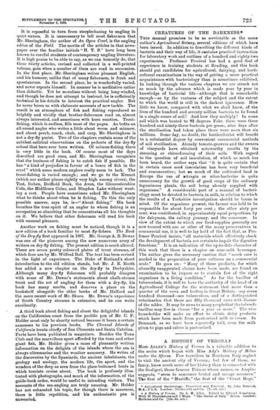CREATURES OF THE DARKNESS.° THIS manual promisee to be as
serviceable as the same author's Agricultural Botany, several editions of which have been issued. In addition to describing the different kinds of bacteria and their way of life, it contains practical instruction for laboratory work and outlines of a hundred and eighty-two experiments. Professor Percival has had a good deal of experience in training students at Reading, and this book should put candidates for agricultural, dairying, and horti- cultural examinations in the way of getting a more practical acquaintance with bacteriology than is sometimes exhibited. In looking through the various chapters we are struck not so much by the advance which is made year by year in knowledge of bacterial life—although that is remarkable enough—as by the vastness of the subject and the extent to which the world is still in the darkest ignorance. How little we know, compared with what we shall know, of the lives of the hundred and seventy million bacteria to be found in a single ounce of soil! And how they multiply ! In some soil which was heated to 82 degrees Fahr. there were three hundred and ninety-three bacteria per gram; nine days after the sterilisation had taken place there were more than six millions. Some day, no doubt, the horticulturist will benefit to a substantial degree by convenient commercial methods of soil sterilisation. Already tomato-growers and the owners of vineyards have obtained noteworthy results by the steaming or chloroforming of their soils. With regard to the question of soil inoculation, of which so much has been heard, the author says that "it is quite certain that in certain cases seed inoculation has been very beneficial and remunerative ; but on much of the cultivated land in Europe the use of nitragin or nitro-bacterine is quite unnecessary for the growth of good crops of the ordinary leguminous plants, the soil being already supplied with organisms." A considerable part of a manual of bacteri- ology must be devoted to bacteria in milk, in relation to which the results of a Yorkshire investigation should be borne in mind. Of the organisms present., the farmer was held to be responsible for about forty per cent.; the other sixty per cent, was contributed, in approximately equal proportions, by the dairyman, the railway journey, and the consumer. In view of the extent to which our food-supplies generally are now treated with one or other of the many preservatives in commercial use, it is well to lay hold of the fact that, as Pro- fessor Percival insists, "all materials which effectively check the development of bacteria are certain to impair the digestive functions." It is an indication of the up-to-date character of this work that there is a chapter on sour-milk beverages. The author gives the necessary caution that "much care is needed in the preparation of pure cultures on a commercial scale." He goes on : "Many of these products, for which absurdly exaggerated claims have been made, are found on examination to be impure or to contain few of the right organisms in a living condition." As for the bacillus of tuberculosis, it is well to have the authority of the head of an Agricultural College for the statement that more than a quarter of the cows and heifers in Great Britain—say seven hundred thousand—are tuberculous, and of a distinguished veterinarian that there are fifty thousand cows with disease of the udder. It may be news to many people that the tubercle bacillus may live in cheese "for a year or more." The wise householder will make an effort to obtain dairy products which have been made from pasteurised milk or cream. In Denmark, as we have been repeatedly told, even the milk given to pigs and calves is pasteurised.


































































 Previous page
Previous page